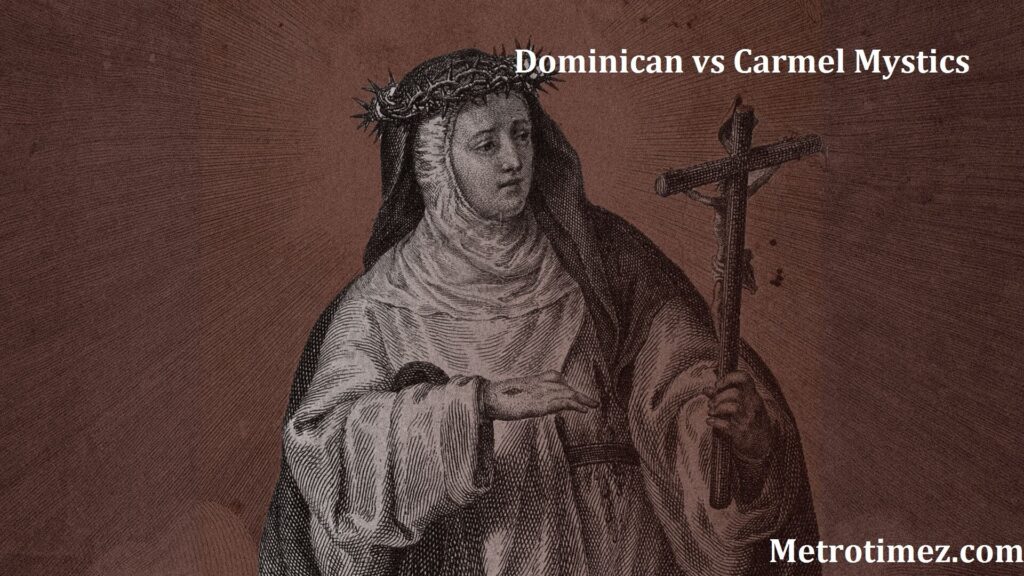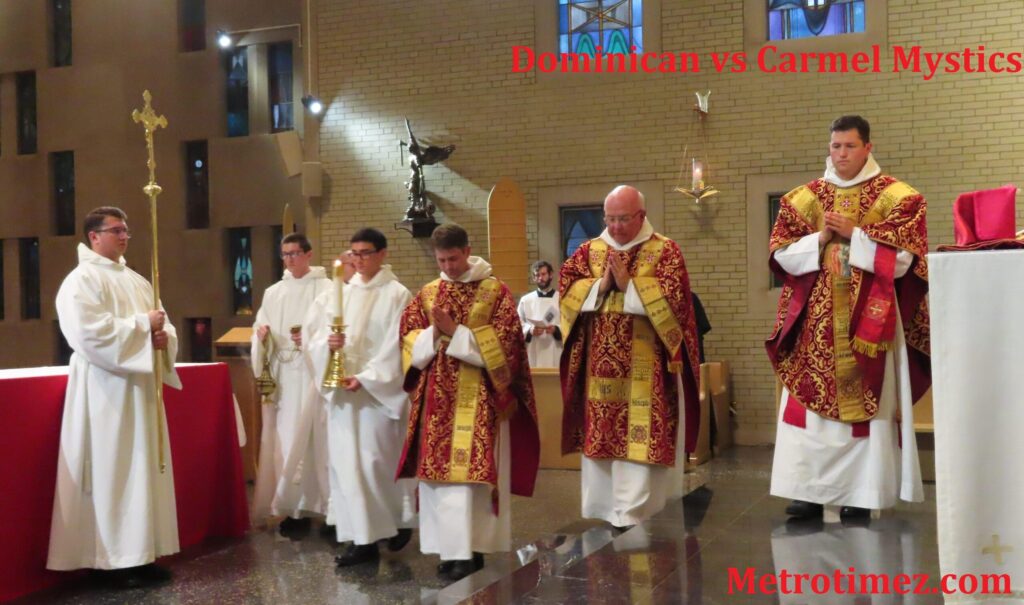
The mystical paths of spirituality have long intrigued seekers and scholars alike. Among the rich tapestry of religious traditions, the Dominican vs Carmel Mystics stand out for their unique approaches to God and contemplation. Both orders offer profound insights into the human experience, yet they diverge in significant ways. Join us as we delve into the fascinating world of Dominican vs Carmel mystics, exploring their historical roots, spiritual practices, and lasting impacts on contemporary faith life. Prepare to uncover a wealth of wisdom that transcends time and tradition!
Dominican vs. Carmel Mystics
Dominican vs Carmel Mystics embody distinctive spiritual journeys. Dominicans emphasize community, preaching, and intellectual inquiry, while Carmelites focus on solitude, contemplation, and inner prayer. Each order nurtures a unique relationship with the divine through their specific practices, shaping how they experience God’s presence in daily life and guiding others along their paths to holiness.
Historical Background Dominican vs Carmel Mystics
The historical roots of Dominican vs Carmel Mystics trace back to medieval Europe. The Dominicans, founded by St. Dominic in the early 13th century, emphasized preaching and education. Meanwhile, the Carmelites originated as hermits on Mount Carmel in the late 12th century, focusing on contemplative prayer and a deep connection with God through solitude.
Carmelite Mysticism Historical Sketches
Carmelite mysticism has deep roots in the early Christian tradition. Emerging from hermits on Mount Carmel, it flourished through significant figures like St. Teresa of Avila and St. John of the Cross. Their writings emphasized personal encounters with God, paving the way for a rich spiritual legacy that continues to inspire seekers today.
Carmelite Spiritual Origin
Carmelite spirituality has roots in the early Christian hermits of Mount Carmel. They sought solitude, prayer, and a deep connection with God. The rich mystical tradition emerged from their experiences, focusing on contemplation and inner silence. This foundation paved the way for later figures like St. Teresa of Avila to further develop Carmelite beliefs.
Hermit and Monastic Life on Mount Carmel
Mount Carmel has long been a sanctuary for hermits seeking solitude and communion with God. The rugged landscape offered both physical isolation and spiritual depth. Monastic life flourished here, rooted in prayer and contemplation, fostering a deep connection to the divine. This sacred site became pivotal in shaping Carmelite spirituality, reflecting a profound yearning for holiness.
Development and Transformation
The Carmelite Order evolved significantly over time. Initially, hermits on Mount Carmel sought solitude and prayer. As the community grew, they transitioned into friars, balancing contemplation with active ministry. The Rule was mitigated to adapt to changing times, leading to reforms like those initiated by St. Teresa of Avila that emphasized deeper spiritual commitment.
Foundation of the Order on Mount Carmel

The foundation of the Carmelite Order on Mount Carmel dates back to the 12th century. Hermits gathered there, seeking solitude and a deeper connection with God. They established small communities, living under a rule that emphasized prayer and contemplation. This marked the beginning of a rich spiritual tradition that would evolve over centuries.
From Hermits to Friars
During the 13th century, Carmelite hermits transitioned from solitary life into a more communal existence. They embraced a friar lifestyle, engaging with society while maintaining their contemplative roots. This shift allowed them to spread their spirituality and teachings beyond the confines of Mount Carmel, fostering deeper connections with local communities and enhancing their mission.
Mitigation of the Rule
The Mitigation of the Rule marked a significant shift for the Carmelites. Originally strict, their regulations softened over time to accommodate evolving spiritual needs. This gradual change allowed members to engage more with society while preserving core principles. The aim was balance: maintaining devotion without compromising daily life and outreach efforts.
Teresian Reform
The Teresian Reform, initiated by St. Teresa of Avila in the 16th century, aimed to return the Carmelite Order to its original contemplative roots. Emphasizing prayer and community life, this movement sought simplicity and a deeper relationship with God. It fostered a renewed devotion that continues to inspire Carmelites today, enriching their spiritual journey.
Controversies and Modernization
Throughout history, the Carmelite Order faced various controversies, notably the Papebroch affair, which questioned its origins. Modernization efforts emerged as members sought to adapt spirituality for contemporary society. Debates on maintaining tradition versus embracing change continue, reflecting the dynamic nature of faith and practice within this revered religious community.
Papebroch Controversy
The Papebroch controversy arose in the 17th century, igniting debates among scholars regarding the authenticity of hagiographies. Critics argued that certain accounts of Carmelite saints were embellished or fabricated. This dispute highlighted the tension between historical accuracy and spiritual devotion, shaping how later generations approached mysticism within both dominican vs carmel mystics traditions.
Modern History
The modern history of the Carmelite Order reflects adaptation and resilience. In response to contemporary challenges, various branches emerged, emphasizing both contemplative prayer and active ministry. This evolution showcases a commitment to spiritual growth while remaining relevant in today’s fast-paced world, attracting new followers who seek deeper connections with their faith and traditions.
Attempts of Reforms
Throughout history, the Carmelite Order has faced various challenges prompting attempts at reform. These movements aimed to return to a more authentic spiritual practice by emphasizing prayer, solitude, and community life. Notable figures emerged during these reformations, advocating for deeper contemplation and a renewed focus on the original charism of Carmel.
Influence and Devotion
Dominican vs Carmel Mystics have profoundly shaped spiritual practices through visions and deep, contemplative devotions. Their writings inspire countless followers today, promoting a rich inner life with God. The various provinces within the Carmelite Order foster unique traditions, allowing diverse expressions of faith while maintaining a strong sense of community and shared purpose among believers.
Visions and Devotions
Carmelite mystics often experienced profound visions, offering glimpses into the divine. These encounters shaped their spirituality and informed various devotions. From Teresa of Avila’s mystical experiences to John of the Cross’s poetry, these insights deepened their connection with God. Such visions continue to inspire contemporary practitioners in their pursuit of holiness and understanding.
Provinces of the Carmelite Order
The Carmelite Order is organized into various provinces, each with its own unique character and traditions. These provinces facilitate the spiritual growth of members while fostering unity in diversity. From Europe to the Americas, each province reflects local culture, enhancing the global reach and impact of Carmelite spirituality across different communities.
Comparison and Contrast
Dominican vs Carmel Mystics both seek divine truth but approach it differently. Dominicans emphasize teaching and preaching, often engaging with the world. In contrast, Carmelites focus on contemplative prayer and inner silence. Their distinct paths highlight various facets of spiritual life, fostering unique expressions of faith that resonate with diverse followers in today’s society.
Exploring Dominican vs Carmel Mystics
Dominican mysticism emphasizes the pursuit of truth through study and contemplation. Rooted in the teachings of St. Dominic, it encourages a deep relationship with God. This path nurtures intellect alongside spirituality, inviting individuals to blend prayer with rigorous theological inquiry, fostering an integrated approach to understanding divine mysteries and human experience alike.
Contrasting Philosophies and Practices
Dominican mystics emphasize an intellectual approach to spirituality. They focus on study and preaching, seeking truth through reason. In contrast, Carmelite mystics prioritize contemplative prayer and inner silence. Their practices foster deep personal encounters with God. Each tradition offers a unique path, reflecting diverse ways of experiencing the divine presence in everyday life.
Relevance Today
The teachings of both Dominican vs Carmel Mystics resonate in today’s spiritual landscape. Many find solace in their writings, exploring deep prayer and contemplation. As modern seekers navigate life’s complexities, these traditions offer profound insights. Celebrating figures like St. Mary Magdalen de Pazzi enriches contemporary spirituality, reminding us of the enduring quest for divine connection and understanding.
Celebrating St. Mary Magdalen de Pazzi, Carmelite
St. Mary Magdalen de Pazzi was a remarkable figure in the Carmelite tradition. Her life, marked by deep prayer and mystical experiences, offers inspiration to many. Celebrating her feast day invites reflection on her profound love for Christ and commitment to spiritual growth, encouraging both devotion and contemplation within the Carmelite community today.
Examination of Contemporary Influence
Contemporary spirituality often draws from both Dominican vs Carmel Mystics. Their teachings encourage personal reflection, community engagement, and active participation in social justice. Various retreats and workshops highlight these traditions, fostering a deeper connection to faith for modern practitioners. The impact of their philosophies resonates in today’s spiritual landscape, inspiring countless seekers worldwide.
Interaction and Engagement Dominican vs Carmel Mystics
Engaging with the rich traditions of Dominican vs Carmel Mystics can deepen your spiritual journey. Explore their writings, join local communities, or participate in online forums. Share your experiences and insights with others who appreciate these mystical paths. Your voice adds to a vibrant dialogue surrounding faith and spirituality across generations.
Contact
We’d love to hear from you! Whether you have questions about Dominican vs Carmel Mystics, want to share insights, or seek further information, reach out. Your thoughts and experiences matter. Feel free to use the contact form below for inquiries, feedback, or anything else on your mind. Let’s connect!
Connect
Engaging with the rich traditions of both Dominican vs Carmel Mystics can deepen your spiritual journey. Join online forums, attend local retreats, or participate in discussion groups. Connecting with fellow seekers fosters community and shared insights. Explore resources that encourage collaboration and exchange ideas about these profound spiritual paths. Dive in and discover!
Share Your Thoughts
The exploration of Dominican vs Carmelite mystics reveals a rich tapestry of spirituality and tradition. Each order has its unique path to God, offering varied insights into the mystical experience. How do these legacies influence your spiritual journey?